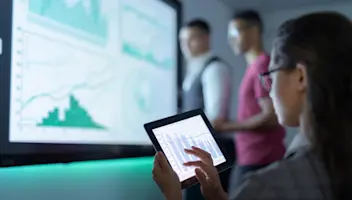Destacado en este post
Get in Sync by Integrating Advanced Software for Food Businesses With ERP Solutions
Get in Sync by Integrating Advanced Software for Food Businesses With ERP Solutions
Oct 3, 2023
John McCurdy
Imagine the ideal tech stack for your food and beverage business. Your various software solutions are all connected to one another, much like the many neurons of your brain. At your setup’s center is an industry-specific enterprise resource planning (ERP) system, with purpose-built features to tackle your unique challenges and integrations for the applications you need.
With a digital foundation like that, your employees are empowered to accomplish vital tasks more efficiently. Rather than switching from one platform to another to move a project along or carry out the last steps of a transaction, they’re able to access it directly from your ERP interface and get more done in less time thanks to that convenience.
And instead of entering data twice, once in the ERP and then again in another program, they can simply key it in once and it’s immediately synced across all integrated software, helping you maintain a “single version of the truth.” Going back to the brain analogy, all synapses are firing, and the complex “organism” that is your company can act in concert to drive progress toward your goals.
We’re speaking about this as a hypothetical, but it’s not just a thought experiment—there are ERP solutions built specifically for the food and beverage industry that offer a wide variety of integrations. As to which would be most critical for your organization will depend on your sector and circumstances, but each offers great potential for operational improvement and additional functionality.
Let’s examine some of the most critical integrations that ERP software for food and beverage businesses can provide, how your company can leverage them and what benefits they can generate. We’ll explore the features of the supplementary solutions to which your ERP can be connected and walk through use cases for each so you have an idea of their real-world relevance.
TMS Integrations To Excel in Distribution
Integrating your ERP with a transportation management system (TMS)—ideally purpose-built routing and scheduling software—can have a transformative effect on your distribution operations. Instead of your planners mapping routes and scheduling deliveries by hand in a spreadsheet, they can generate routes optimized for fuel conservation and efficiency with just a few clicks.
What’s more, advanced route optimization software—like Aptean Routing & Scheduling Paragon Edition—also offers strategic route planning functionality, which can be used to model the outcomes of changes you might consider, from adding trucks to the fleet to opening a new dispatch center. Our software also has specific functionalities for food and beverage, including the must-have ability to create temperature zones for perishables.
BI Integrations To Harness the Power of Data
Companies that struggle to get the kind of detailed, industry-specific performance metrics from their existing food manufacturing software often look to business intelligence (BI) to truly make the best of their data and analyze it for actionable insights. These applications track hundreds of key performance indicators (KPIs) and provide analysis of trends in your data at a granular level.
BI software also offers scenario modeling, and in this case, it can be used to gauge the potential effects of a shift to a new supplier or an increase in prices, among many other examples. Aptean’s BI solution can be integrated with our food ERP to track more than 500 KPIs—over 300 of which are unique to the food and beverage industry—so that you can monitor performance in detail.
EDI Integrations To Meet Customers’ Requirements
When discussing food industry software, we frequently focus on tools that suit the demands of internal operations, but it’s also important to keep in mind those capabilities that help you meet the demands of your customers. Along those lines, having an electronic data interchange (EDI) application integrated with your ERP can allow you to satisfy the requirements of even the most demanding of clients.
By fully digitizing the exchange of data and documents between trading partners, leading platforms like Aptean EDI provide a higher level of security and minimize the chances of human error. Transacting with EDI is commonly required by larger retailers, including big-box supermarkets, so it’s especially essential for food and beverage organizations that want to serve those customers.
Payment Solution Integrations To Streamline Transactions
Making purchases via digital payment platforms has become so common as to be a near-daily occurrence for most of us. That's also true in the world of food and beverage businesses, as a faster, more convenient experience is not only most customers’ preference but an expectation. Thus, integration with a payment solution for your ERP is a must-have.
By deploying an online payment system, you can streamline transactions significantly—no more waiting around for physical checks to arrive, as customers can pay immediately when they receive a digital invoice. And via integration with an online payment platform like Aptean Pay, you can also improve the accuracy of your financial reporting, as accounting information is reconciled immediately in your ERP.
CRM Integrations To Promote Better Customer Service
Happy clients are more likely to be repeat clients, and by providing a positive experience at every touchpoint, you can forge partnerships and help create your own brand champions. That requires an effective means for serving trading partners, so it’s crucial to have customer relationship management (CRM) features to track interactions, facilitate service and act as a repository for all client data.
With CRM functionalities at their fingertips, your sales and service professionals will have the tools they need to promptly resolve inquiries, schedule follow-ups and fetch client information in a flash. Aptean Food & Beverage ERP is integrated with CRM capabilities that afford you a complete view of each customer, including their historical purchases and preferences, and maintain a fruitful relationship.
Building a Tech Stack With a Single Solution Provider
Now that we’ve looked at several of the most vital integrations to implement with your ERP solution, you’re aware of how far you can extend the functionality of your tech stack and establish stronger connections between your platforms. You now also probably have a better sense of just how vital digital transformation in the food industry is—and that process is best approached with a sound strategy.
You can begin by assessing your company’s needs, as well as your many options for software for food companies available on the market, but you should also look for a provider that can meet your needs. You’re looking for a partner, not just a vendor ready to sell you a product—and you're also best served trusting in a single provider who can provide a complete solution suite.
Enter Aptean, a leader in industry-specific business software with a strong track record of commitment to the food and beverage industry. We offer an award-winning ERP system for food and beverage organizations, all of the supplementary applications listed above and purpose-built overall equipment effectiveness (OEE) and enterprise asset management (EAM) solutions that integrate with our ERPs.
Furthermore, we provide flexible cloud deployments on the Software as a Service (SaaS) model, which can afford your company with greater scalability, enhanced cybersecurity, secure data protection and broader accessibility. Our team knows the food and beverage industry well, including the tough challenges that come with it and the best practices to overcome them.
Want to learn more about Aptean Food & Beverage ERP and its game-changing integrations with a variety of supplementary platforms? Contact us today, or request a personalized demo.
Related Content





¿Todo listo para transformar tu negocio?
Tenemos las soluciones ERP especializadas que necesitas para superar los desafíos de tu sector.



